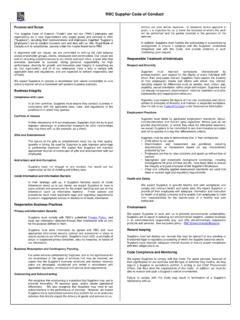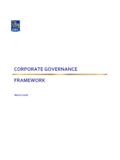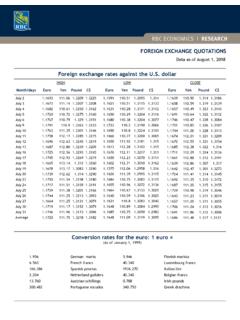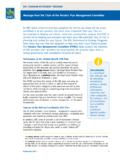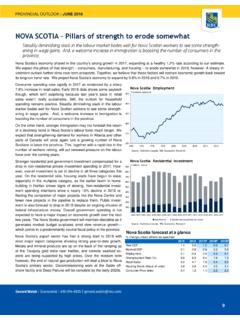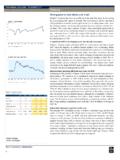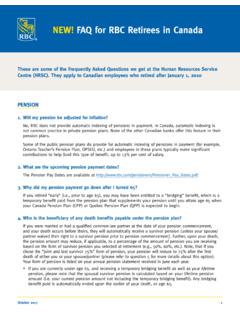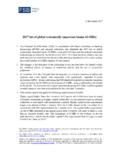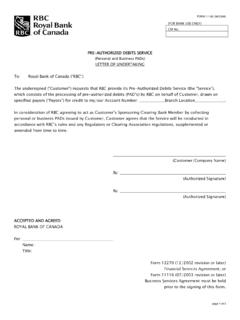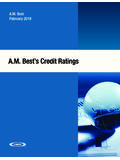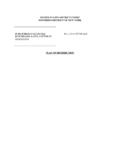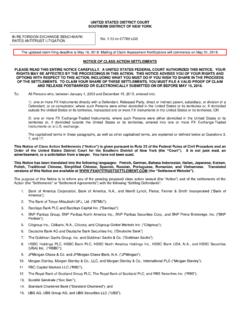Transcription of GLOSSARY - RBC
1 royal bank OF CANADA141 ANNUAL REPORT 2005 > GLOSSARYA cceptancesA bill of exchange or negotiable instrumentdrawn by the borrower for payment at maturityand accepted by a bank . The acceptance constitutes a guarantee of payment by thebank and can be traded in the money bank earns a stamping fee for providingthis for credit lossesThe amount deemed adequate by manage-ment to absorb identified and probable creditrelated losses in the portfolio of loans, acceptances, guarantees, letters of credit,deposits with other banks and derivatives. The allowance is increased by the provision forcredit losses, which is charged to income anddecreased by the amount of write-offs, net multipleTotal assets plus specified off-balance sheetitems divided by total regulatory under administration (AUA)Assets administered by a financial institution,which are beneficially owned by clients andare therefore not reported on the ConsolidatedBalance Sheets.
2 Services provided in respectof assets under administration are of anadministrative nature, including safekeeping,collecting investment income, settling purchase and sale transactions, and under management (AUM)Assets managed by a financial institution,which are beneficially owned by clients and are therefore not reported on the ConsolidatedBalance Sheets. Services provided in respect of assets under management include theselection of investments and the provision ofinvestment advice. Assets under managementmay also be administered by the point (bp)One one-hundredth of a percentage point(.01%).BetaThe measure of a security s volatility relativeto a market GAAPC anadian generally accepted accounting ratioThe percentage of risk-adjusted assets supported by capital using the guidelines of the Office of the Superintendent of FinancialInstitutions canada based on standardsissued by the bank for InternationalSettlements and Canadian capital positionQuantifies the extent to which illiquid assetsare funded by non-core liabilities and repre-sents a formula-based measure of both com-parative and directional structural liquidity Debt Obligation (CDO)
3 An investment grade security backed by a pool of bonds, loans and/or any other type ofdebt clientsGenerally, private companies with revenue inexcess of $20 million and less than $1 , clients with revenue of less than$100 million are served in canada by our RBCC anadian Personal and Business segment andin the RBCC entura in our RBC Personal and Business and larger commercial clients withfrequent need to access capital markets andmore sophisticatedfinancing requirements areserved by our RBCC apital Markets to extend creditCredit facilities available to clients either in the form of loans, bankers acceptances andother on-balance sheet financing, or throughoff-balance sheet products such as guaranteesand letters of of capitalManagement s estimate of its weighted average cost of equity and debt contract between two parties where pay-ments between the parties are dependentupon the movements in price of an underlyingasset, index or financial rate.
4 Examples ofderivatives include swaps, options, forwardrate agreements and futures. The notionalamount of the derivative is the contractamount used as a reference point to calculatethe payments to be exchanged between thetwo parties and the notional amount itself isgenerally not exchanged by the payout ratioCommon dividends as a percentage of netincome after preferred share yieldDividends per common share divided by theaverage of the high and low share prices in the relevant and commercial letters of creditWritten undertakings by a bank on behalf ofits client (typically an importer), authorizing a third party ( , an exporter) to draw draftson the bank up to a stipulated amount under specific terms and conditions. Such undertak-ings are established for the purpose of facilitating international per share (EPS), basicNet income less preferred share dividendsdivided by the average number of shares per share (EPS), dilutedNet income less preferred share dividendsdivided by the average number of shares outstanding adjusted for the dilutive effects ofstock options and other convertible Capital (EC)An estimate of the amount of equity capitalrequired to underpin risks.
5 It is calculated by estimating the level of capital that is necessary to support our various businesses,given their risks, consistent with our desiredsolvency standard and credit and standby letters of creditPrimarily represent irrevocable assurancesthat a bank will make payments in the eventthat its client cannot meet its financial obliga-tions to third parties. Certain other guarantees,such as bid and performance bonds, representnon-financial risk management technique used to insulatefinancial results from market, interest rate or foreign currency exchange risk (exposure)arising from normal banking operations. The elimination or reduction of such exposureis accomplished by establishing offsettingpositions. For example, assets denominated inforeign currencies can be offset with liabilitiesin the same currencies or through the use offoreign exchange hedging instruments such asfutures, options or foreign exchange loansLoans are classified as impaired when therehas been a deterioration of credit quality tothe extent that management no longer hasreasonable assurance of timely collection of the full amount of principal and interestaccording to the contractual terms of the loan bank OF canada ANNUAL REPORT 2005 > GLOSSARYI nnovative capital instrumentsRBC s innovative capital instruments are transferable trust units issued by the RBCC apital Trust and RBC Capital Trust II specialpurpose entities.
6 Innovative capital can comprise up to 15% of net Tier 1 capital withan additional 3% eligible for Tier 2B retrocessionLife insurance assumed from a of financial instruments using prevailing market prices or fair value as of thebalance sheet netting agreementAn agreement designed to reduce the creditrisk of multiple derivative transactionsthrough the creation of a legal right of offset of exposure in the event of a interest incomeThe difference between what is earned onassets such as loans and securities and whatis paid on liabilities such as deposits and subordinated interest marginNet interest income as a percentage of average course issuer bidA repurchase of our own shares, for cancella-tion through a stock exchange; it is subject tothe various rules of the relevant exchange andsecurities amountThe contract amount used as a reference pointto calculate payments for sheet financial instrumentA variety of products offered to clients whichfall into two broad categories: (i) credit relatedarrangements, which generally provide clientswith liquidity protection, and (ii) derivatives,which are defined on the previous of the Superintendent of FinancialInstitutions canada (OSFI)The primary regulator of federally charteredfinancial institutions and federally adminis-tered pension plans in canada .
7 TheOSFI s mis-sion is to safeguard policyholders, depositorsand pension plan members from undue pension benefit costThe cumulative excess of amounts contributedto a pension fund over the amounts recordedas pension for credit lossesThe amount charged to income necessary tobring the allowance for credit losses to a leveldetermined appropriate by agreements (REPOS)Involve the sale of securities for cash at a nearvalue date and the simultaneous repurchaseof the securities for value at a later on common equity (ROE)Net income, less preferred share dividends,expressed as a percentage of average common repurchase agreements (reverse REPOS)Involve the purchase of securities for cash at a near value date and the simultaneous saleof the securities for value at a later institutions face a number of differentrisks that expose them to possible risks include credit risk, market risk, liq-uidity risk, insurance risk and operational assetsUsed in the calculation of risk-based capitalratios.
8 The face value of assets is discountedusing risk-weighting factors in order to reflecta comparable risk per dollar among all typesof assets. The risk inherent in off-balancesheet instruments is also recognized, first bydetermining a credit equivalent amount, andthen by applying appropriate lendingTransactions in which the owner of a securityagrees to lend it under the terms of a pre-arranged contract to a borrower for a fee. The borrower must fully collateralize the secu-rity loan at all times. An intermediary such as abank often acts as agent for the owner of thesecurity. There are two types of securitieslending arrangements, lending with and without credit or market risk securities lending without indemnification,the bank bears no risk of loss.
9 For transactionsin which the bank provides an indemnification,risk of loss occurs if the borrower defaults and the value of the collateral declines sold shortA transaction in which the seller sells securitiesand then borrows the securities in order todeliver them to the purchaser upon a later date, the seller buys identical securi-ties in the market to replace the process by which high-quality financialassets are packaged into newly issued securities backed by these purpose entities (SPEs)SPEs are entities that are typically organizedfor a single discrete purpose, have a limitedlife and serve to legally isolate the financialassets held by the SPEfrom the selling organi-zation. SPEs are principally used to securitizefinancial and other assets in order to obtainaccess to funding, to mitigate credit risk andto manage equivalent basis (teb)A non-GAAP measure that increases incomefrom tax-advantaged sources to a level thatwould make it comparable to income from taxable sources.
10 There is an offsetting adjust-ment in the tax provision, thereby generatingthe same after-tax net income as reportedunder Capital Securities (RBC TruCS)Transferable trust units issued by RBCC apitalTrust or RBCC apital Trust II for the purpose ofraising Innovative Tier 1 accepted accounting (VAR)A generally accepted risk-measurement concept that uses statistical models toestimate within a given level of confidence themaximum loss in market value that the bankwould experience in its trading portfolios froman adverse one-day movement in market ratesand interest entity (VIE)A variable interest entity is an entity whicheither does not have sufficient equity at risk tofinance its activities without additional subor-dinated financial support or where the holdersof the equity at risk lack the characteristics ofa controlling financial interest.

